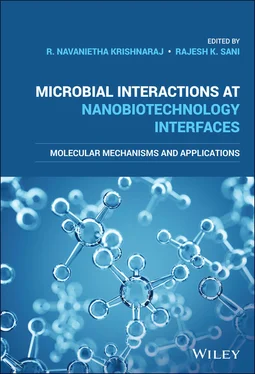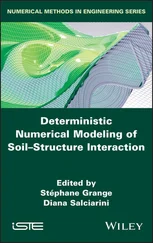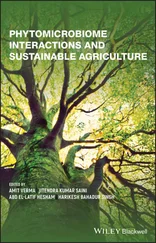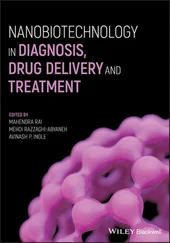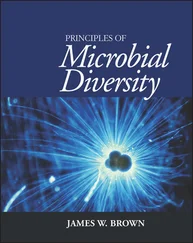Microbial Interactions at Nanobiotechnology Interfaces
Здесь есть возможность читать онлайн «Microbial Interactions at Nanobiotechnology Interfaces» — ознакомительный отрывок электронной книги совершенно бесплатно, а после прочтения отрывка купить полную версию. В некоторых случаях можно слушать аудио, скачать через торрент в формате fb2 и присутствует краткое содержание. Жанр: unrecognised, на английском языке. Описание произведения, (предисловие) а так же отзывы посетителей доступны на портале библиотеки ЛибКат.
- Название:Microbial Interactions at Nanobiotechnology Interfaces
- Автор:
- Жанр:
- Год:неизвестен
- ISBN:нет данных
- Рейтинг книги:4 / 5. Голосов: 1
-
Избранное:Добавить в избранное
- Отзывы:
-
Ваша оценка:
- 80
- 1
- 2
- 3
- 4
- 5
Microbial Interactions at Nanobiotechnology Interfaces: краткое содержание, описание и аннотация
Предлагаем к чтению аннотацию, описание, краткое содержание или предисловие (зависит от того, что написал сам автор книги «Microbial Interactions at Nanobiotechnology Interfaces»). Если вы не нашли необходимую информацию о книге — напишите в комментариях, мы постараемся отыскать её.
Microbial Interactions at Nanobiotechnology Interfaces — читать онлайн ознакомительный отрывок
Ниже представлен текст книги, разбитый по страницам. Система сохранения места последней прочитанной страницы, позволяет с удобством читать онлайн бесплатно книгу «Microbial Interactions at Nanobiotechnology Interfaces», без необходимости каждый раз заново искать на чём Вы остановились. Поставьте закладку, и сможете в любой момент перейти на страницу, на которой закончили чтение.
Интервал:
Закладка:
1.5.1 Mechanism of Antibiotic Resistance
The mechanism of bacterial antibiotic resistance can be categorized into intrinsic and extrinsic. The antibiotic resistance mechanism that fixed in the genetic core of the organisms is an intrinsic mechanism encoded in chromosomes. This may include the enzyme system which inactivates antibiotics, nonspecific efflux pump systems, and permeability barrier mechanisms (Cox & Wright, 2013; Fajardo et al., 2008). AcrAB/TolC efflux pump in E. coli is one of the well‐studied intrinsic resistance systems. These efflux systems are generally very nonspecific and help in exporting different antibiotics, detergents, dyes, and disinfectants (Nikaido & Takatsuka, 2009). Similarly, a mechanism involving permeability barrier in E. coli and other Gram‐negative bacteria for vancomycin is also an intrinsic resistance system where the outer membrane acts as a permeability barrier (Arthur & Courvalin, 1993). On the other hand, the resistance system that is obtained from other organisms such as producers by horizontal gene transfer is called the acquired resistance system. Unlike the intrinsic resistance system, the resistance elements of the acquired systems are generally embedded in plasmids and transposons. Acquired resistance system includes the plasmid‐encoded specific efflux pumps and enzymes that can alter or modify the antibiotics or the target of antibiotics (Bismuth et al., 1990).
According to Wang, Hu, and Shao (2017), the resistance mechanism can be categorized into different subdivisions on the basis of the biochemistry at the protein level target alterations, passive or inactive enzyme generation, active efflux pumps, permeability barrier, biofilm formation, elimination and emergence of certain specific protein. It has been noted that in the same bacterium there may exist two or more simultaneous mechanisms from the aforementioned categories as resistance mechanism such as antagonist induction through metabolic pathway and production of competitive inhibitor to counteract the antibiotics. In general, the molecular mechanisms of antibiotic resistance are divided into three types: (i) antibiotic modification, (ii) antibiotic efflux, and (iii) target modification or bypass or protection mechanisms (Wang et al., 2017).
1.5.1.1 Antibiotics Modification
Antibiotics modification is the common resistance mechanism of pathogenic bacteria against antibiotics of aminoglycosides class. So far, multiple types of aminoglycosides modifying enzymes (AMEs) have been identified in both Gram‐negative and Gram‐positive bacteria (Ramirez and Tolmasky, 2010; Schwarz et al., 2004). The genetic code for these systems is embedded in the mobile genetic elements (MGEs) of pathogenic or resistant bacteria (Ramirez & Tolmasky, 2010). The chromosomal determinants of the aminoglycosides modifying enzymes have been found in the large number of bacteria present in the environment such as Acinetobacter and Providencia . These chromosomal determinants are the sources from where pathogenic strains acquired the genetic codes onto their mobile genetic elements (Schwarz et al., 2004). A well‐known AME is the N ‐acetyl transferase, which acetylates the aminoglycosides. Apart from AMEs, chloramphenicol acetyltransferase (CAT) and antibiotic hydrolyzing enzyme β‐lactamases belong to the same group of enzymes that acts on the antibiotics and modifies them (Martinez, 2018; Schwarz et al., 2004).
1.5.1.2 Antibiotic Efflux
The second most common mechanism of antibiotic resistance is antibiotic efflux and permeability barrier. As we discussed earlier, the permeability barrier mechanism is mostly availed by the greatest number of Gram‐negative bacteria. The presence of an extra outer membrane in Gram‐negative bacteria exhibits a barrier against hydrophilic antimicrobial agents and antibiotics such as vancomycin. However, a mutation in the genes related to outer membrane such as porin or even change in their expression level makes them vulnerable to hydrophilic antibiotics (Li et al., 2012).
The antibiotic efflux pumps in bacteria are categorized into five different families: ATP‐binding cassette (ABC), major facilitator superfamily (MFS), resistance–nodulation–division (RND), small multidrug resistance (SMR), and multidrug and toxin extrusion (MATE) (Sun, Deng, & Yan, 2014). Among these, only ABC family proteins use ATP as an energy source for efflux whereas the rest couple the export of their substrate with ion gradients. The acquired determinants of the efflux system are generally located on the plasmids in the pathogenic bacteria such as Tet genes. At least 22 genes have been identified in both Gram‐positive and Gram‐negative bacteria (Roberts, 2005). In pathogenic bacteria, the resistance–nodulation–division (RND) pump systems are operative synergistically with the Tet pump systems. The simple Tet protein effluxes the tetracycline into periplasm where RND captures and exports it outside. This is the plausible reason for increase in the minimum inhibitory concentration of tetracycline against pathogenic bacteria (Lee et al., 2000).
1.5.1.3 Target Modification or Bypass or Protection
The resistant mechanism involving target modification and protection has been also observed in various clinically resistant strains of bacteria. A typical example of target modification is found in methicillin‐resistant Staphylococcus aureus (MRSA) strains. In MRSA strains, the resistance mechanism to β‐lactams is conferred by the exogenous penicillin‐binding protein (PBP) called PBP2a. The acquired PBP2a is devoid of trans‐glycosylase activity; hence, it acts along with native PBP2 to confer the β‐lactams. PBP2a coded by mecA gene is located in large mobile genetic elements called staphylococcal chromosomal cassette (Fishovitz et al., 2014; Liu et al., 2016). Another example of target modification is vancomycin resistance in enterococci. The acquired vancomycin resistance genes called “van gene clusters” are located on the mobile genetic elements. Among the different types of van clusters, vanA and vanB are the most effective resistant systems as they are found in critical clinical strains (Miller, Munita, & Arias, 2014).
1.6 Microbial Resistance: Role of NMs
Every year millions of people suffer from severe illness due to antibacterial resistance and the mortality rate is expected to reach 10 million by 2050 (Gupta et al., 2019). For patients having such infections, antibiotic therapy is the most common treatment used with removal of infected tissue in few cases. There are many disadvantages to such treatments. Along with the high cost, these treatments make the condition worse by increasing antibiotic tolerance of the surviving bacteria. Therefore, it becomes important to find new ways to tackle such problem. Recent advancement in the field of nanotechnology provides new prospects to develop novel NMs with antimicrobial properties. Various NMs have been synthesized to defend against multidrug resistance (MDR) and microbial resistance. NMs have the ability to act not only against bacteria but also as carrier for synthetic and natural antimicrobial compounds. Different NMs have different mechanisms to combat bacteria.
1.6.1 Overcoming the Existing Antibiotic Resistance Mechanisms
Most kinds of NMs can defeat a minimum of one among the prevalent resistance mechanisms mentioned in Section 1.5.1. These impacts are the consequences of NMs' bactericidal mode, which is based on their physicochemical properties. Unlike traditional antibiotics, the characteristic sizes of NPs are 1–100 nm, which gives them novel properties like better interactions with cells (Huh & Kwon, 2011). How the NMs interact with the cell barriers and disrupt the bacterial cell membrane is discussed in this section. Since few mutations cannot change bacterial cell membrane, it further reduces the chance of drug resistance.
Читать дальшеИнтервал:
Закладка:
Похожие книги на «Microbial Interactions at Nanobiotechnology Interfaces»
Представляем Вашему вниманию похожие книги на «Microbial Interactions at Nanobiotechnology Interfaces» списком для выбора. Мы отобрали схожую по названию и смыслу литературу в надежде предоставить читателям больше вариантов отыскать новые, интересные, ещё непрочитанные произведения.
Обсуждение, отзывы о книге «Microbial Interactions at Nanobiotechnology Interfaces» и просто собственные мнения читателей. Оставьте ваши комментарии, напишите, что Вы думаете о произведении, его смысле или главных героях. Укажите что конкретно понравилось, а что нет, и почему Вы так считаете.
